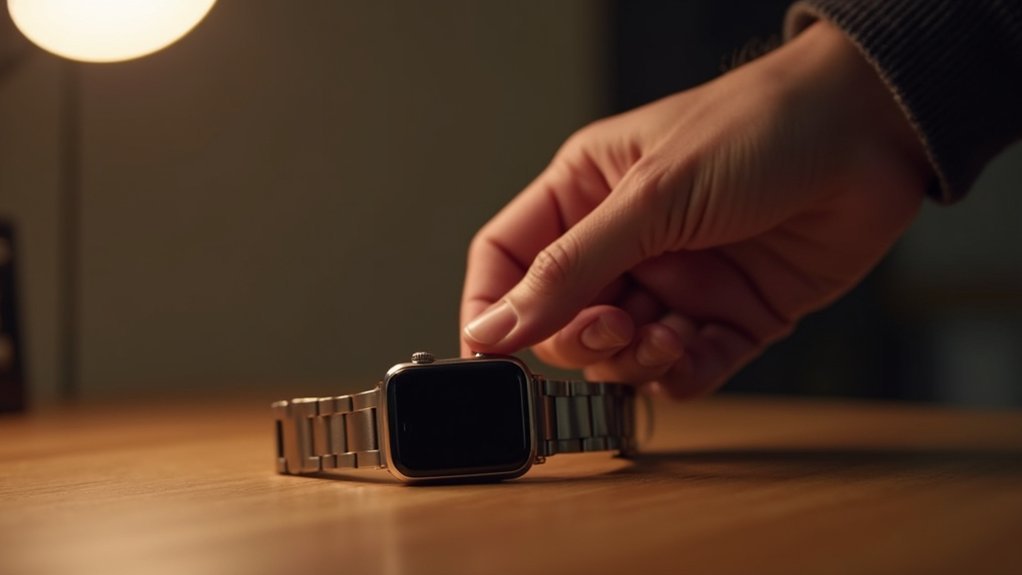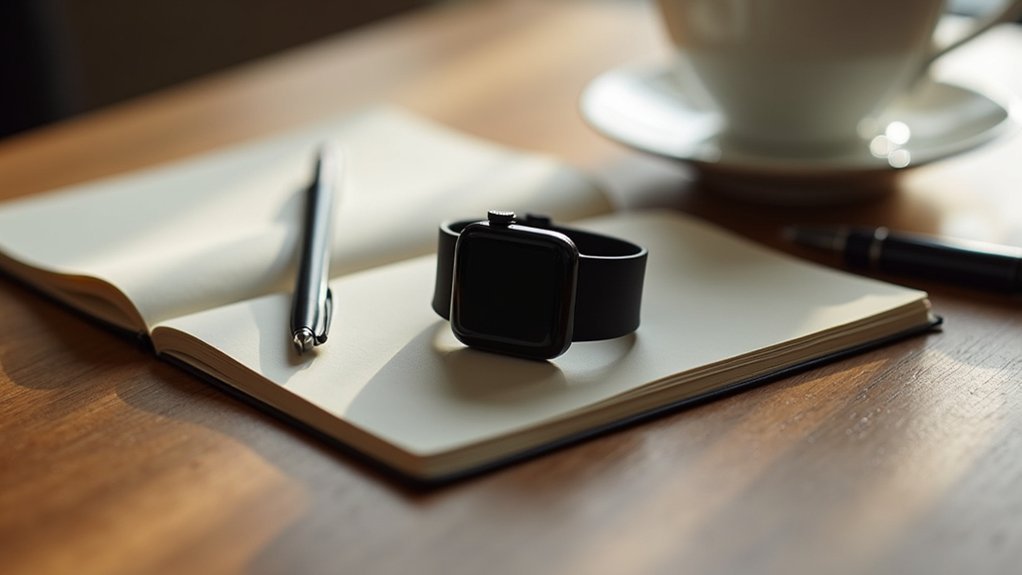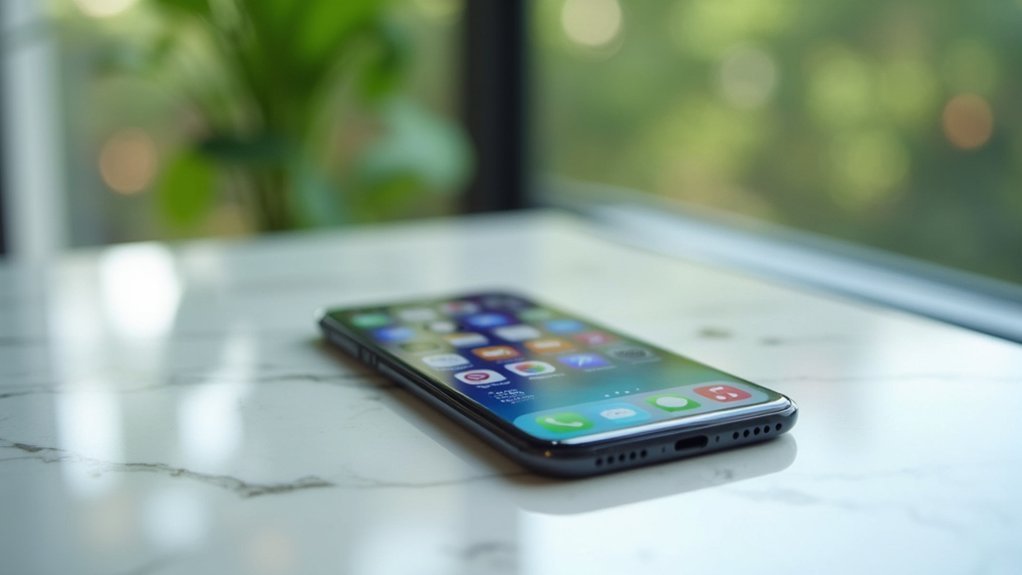You can master notification control by enabling wrist gestures in Settings for one-handed operation, customizing notification categories to group similar alerts, and setting up smart timing windows that align with your workflow breaks. Configure haptic feedback intensity to improve swipe recognition without draining battery, and optimize display duration with auto-dismiss settings for low-priority messages. These strategic techniques will transform your phone into a productivity tool rather than a constant distraction source, and implementing them properly opens up even more advanced management capabilities.
Master the Wrist Flick: Perfecting Your Swipe Gesture Technique

The wrist flick transforms how you’ll interact with notifications, offering seamless one-handed control that works whether you’re juggling groceries, mid-jog, or simply want to keep your other hand free.
Mastering this technique requires consistent practice and proper setup. Navigate to Settings > Advanced features > Gestures > Wrist Gestures On to enable the feature. Device tutorials will familiarize you with sensitivity thresholds and ideal flick ranges.
Focus on deliberate, consistent movements rather than random wrist snaps. Each gesture triggers specific system key events like `KEYCODE_NAVIGATE_NEXT` for scrolling forward. Remember that shaking the wrist serves as a universal back or undo command across all applications.
Practice helps you avoid accidental triggers while improving detection accuracy. With repetition, you’ll achieve rapid notification scrolling and dismissal without touching your screen, making interaction faster and more intuitive.
Customize Notification Categories for Streamlined Dismissal
While notification overload can quickly transform your device from helpful assistant to overwhelming distraction, smart categorization puts you back in control.
You’ll want to group notifications by type—social media, emails, messages—then assign priorities based on importance. Critical work emails deserve immediate attention, while social updates can wait.
Use labels to make categories instantly identifiable, and set up automated sorting to handle routine organization. Configure customizable triggers using content keywords to automatically route notifications into designated categories. This prevents your notification panel from becoming an unmanageable mess.
Implement swipe actions differently across categories—dismiss social notifications with one gesture, archive emails with another.
You can also mute entire categories during focus time, ensuring only essential notifications break through when you need concentration most. Like effective procurement systems, notification management requires continuous improvement as your digital habits and priorities evolve over time.
Set Up Smart Timing Windows to Minimize Gesture Fatigue

Beyond organizing your notifications by category, strategic timing windows can dramatically reduce the physical strain of constant swiping throughout your day. You can set specific check times instead of responding to every ping, concentrating your swipe gestures into focused sessions that prevent repetitive fatigue.
Configure smart notification windows that align with your natural workflow breaks. Schedule automated reviews during lunch or between meetings, allowing AI-powered tools to pre-sort urgent messages. You’ll reduce swipe frequency while maintaining responsiveness to critical communications.
Implement dynamic scheduling that adapts to your activity patterns. During focused work periods, silence non-essential alerts completely. This approach minimizes interruptions and creates predictable gesture sessions, giving your hands regular rest periods while keeping you connected to important updates. Consider enabling app intelligence services that can automatically evaluate and filter notifications based on safety and relevance criteria.
Configure Haptic Feedback Intensity for Better Swipe Recognition
Since your fingers rely on tactile feedback to confirm successful swipe actions, optimizing haptic intensity creates a more responsive notification management experience.
Navigate to Settings and find “Sounds And Vibration” or “Vibration & Haptics” depending on your device model. Use the intensity sliders to adjust vibration strength for touch feedback, ensuring it’s noticeable without being distracting.
Samsung devices offer detailed settings under “Vibration Intensity,” while Google Pixels provide options through “Sound & vibration > Vibration & haptics.” For Android 14 users, check “Accessibility” then “Vibration and Haptics.”
Some devices like Fairphone 4 only offer on/off options rather than intensity control. Disabling haptic feedback can improve battery life by reducing energy consumption from the vibration motor.
Custom keyboards like Gboard provide additional vibration adjustments beyond your device’s settings, giving you more precise control over typing feedback.
Optimize Display Duration and Auto-Dismiss Settings

Finding the right balance between notification visibility and user convenience requires fine-tuning your device’s display duration and auto-dismiss settings.
You’ll want shorter display times for simple, low-priority alerts and longer durations for detailed or urgent messages. Tailor these settings to your personal behavior patterns for best results.
Implement auto-dismiss mechanisms to prevent notification clutter and maintain a clean interface.
Dynamic auto-dismiss based on your interaction patterns reduces manual swiping while keeping important information accessible. Configure these settings to be customizable since your preferences will differ from other users.
Research shows that personalized timing can boost engagement by up to 40%, but overusing notifications leads to app uninstalls. Users who receive notifications within the first 90 days show significantly higher retention rates compared to those who don’t receive early engagement.
Aim for 2-3 notifications daily and prioritize clarity and relevance to maintain satisfaction.
Frequently Asked Questions
Can I Swipe Notifications While Wearing Gloves or With Wet Hands?
You can swipe notifications wearing nitrile gloves or dedicated touchscreen gloves with conductive fingertips. Wet hands may work but cause erratic responses. Confirm proper glove fit and dry your screen for best results.
Do Swiped Notifications Affect My App Engagement Metrics or Analytics?
Swiped notifications don’t increase your app’s open rates or click-through rates since you’re not opening the app. However, they can still boost brand awareness and might influence opt-out rates if you find them annoying.
Will Frequent Swiping Drain My Device Battery Faster Than Normal?
Frequent swiping won’t greatly drain your battery. Individual swipes use minimal power compared to screen-on time and background app activity. Your device’s display and background processes consume far more energy than notification gestures.
Can I Recover Accidentally Dismissed Important Notifications From Earlier Today?
You can recover accidentally dismissed notifications if your Android device has notification history enabled. Check Settings > Notifications > Notification History to view dismissed notifications from the last 24 hours.
Do Notification Swipe Gestures Work the Same Across All Apps?
No, notification swipe gestures don’t work identically across all apps. While iOS and Android have system-level standards, individual apps can implement custom swipe gestures that differ from your device’s default notification controls.





Leave a Reply